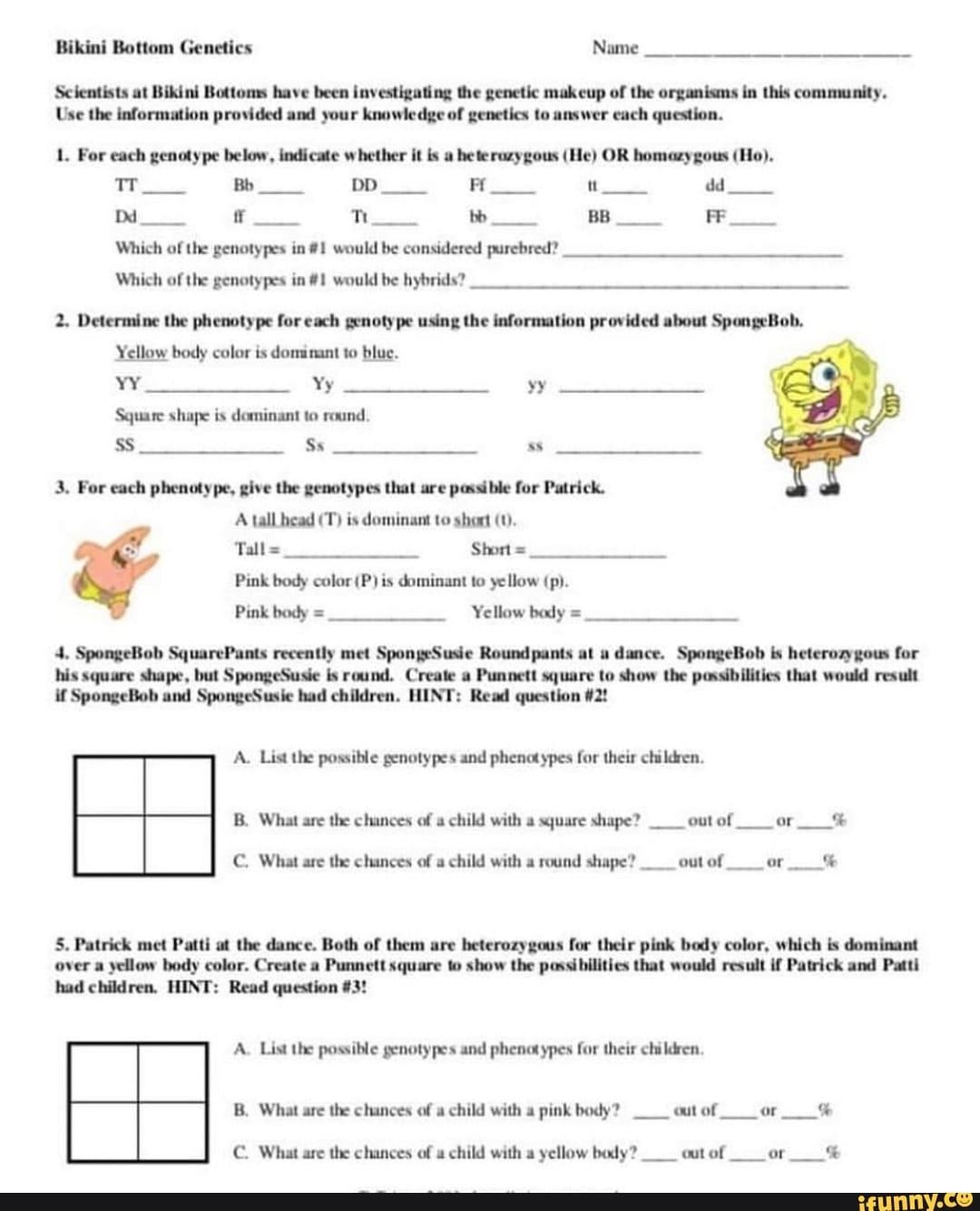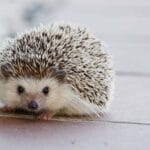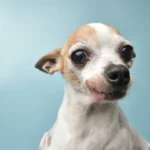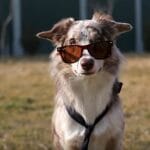Get ready to dive into the wacky world of Bikini Bottom, where science gets a hilarious twist! We’re going to uncover the secrets that make SpongeBob and his pals so uniquely special. From SpongeBob’s pineapple home to Patrick’s famous rock, we’ll explore how genes might have shaped their appearances and personalities. Picture this: science meets Spongebob, where laughter and learning become a sponge-tastic adventure!
Unveiling the Mystery: What Makes SpongeBob So Square?
Ever watched SpongeBob SquarePants and wondered how those wacky characters came to be? Let’s dive into the crazy world of Bikini Bottom genetics and explore the science behind SpongeBob’s square shape and Patrick’s pink hue! Believe it or not, these cartoon creatures can teach us a thing or two about real-life genetics.
Cracking the Genetic Code: Dominant and Recessive Traits
A popular educational resource, Bikini Bottom Genetics, digs into the genetic makeup of our favorite absorbent friend. According to them, SpongeBob’s square shape is a dominant trait, passed down through his family tree.
Here’s where things get interesting: SpongeBob’s parents weren’t both square. This little tidbit tells us that SpongeBob also carries the recessive gene for roundness, inherited from his round parent. What does that mean for any potential mini-SpongeBobs? If he were to have kids with a round sponge, their offspring would have a 50/50 shot at being either square or round. Genetics, huh? Fascinating!
However, not everyone is convinced that simple genetics can fully explain SpongeBob’s unique physique. Some observant fans have a different theory – one that takes into account the environment of Bikini Bottom. They suggest that the nearby nuclear testing site, a recurring element in the show, could be a factor. Could the radiation have something to do with the unusual traits we see in the Bikini Bottom residents, including SpongeBob’s square shape? This theory adds a whole new layer to the show, prompting us to think about the impact of human actions on the environment and the creatures who live in it.
While we may never know for sure what made SpongeBob so uniquely square, exploring these possibilities, whether through genetics or environmental factors, is a fun way to engage with the show’s wacky universe. It reminds us that even in a cartoon as seemingly simple as SpongeBob, there are always deeper layers waiting to be uncovered.
From SpongeBob to Squidward: Decoding Dominant and Recessive Traits
Think about Squidward and his family. Their signature light blue skin is likely a dominant trait in Bikini Bottom. This means that if a Squidward-family member has even one copy of the “blue skin gene,” they’re probably going to be blue. Now, let’s say Squidward’s wife has light green skin, which we know is a recessive trait. This suggests that to be green, she needs two copies of the “green skin gene.”
So, what happens if little Squidlings come along? Squidward, being blue, could have either two blue skin genes or one blue and one green gene. If he’s carrying a hidden green gene, their offspring have a chance of inheriting green skin, even though both parents aren’t green. There’s roughly a 25% chance a little Squidling will inherit two green genes, one from each parent, and end up with green skin.
These principles of dominant and recessive traits aren’t just limited to the wacky world of Bikini Bottom. They apply to all sorts of organisms, including us humans! Think about eye color. Brown eyes are generally dominant over blue eyes. If you have one parent with brown eyes and one with blue eyes, chances are you’ll end up with brown eyes. But, just like with Squidward’s potential green-skinned offspring, you might carry the “blue eye gene” and could potentially pass it on to your own children.
Here’s a simplified way to visualize it:
| Gene Combination | Resulting Trait (Eye Color) |
|---|---|
| Two Brown Eye Genes (BB) | Brown Eyes |
| One Brown, One Blue Eye Gene (Bb) | Brown Eyes (Brown is dominant) |
| Two Blue Eye Genes (bb) | Blue Eyes |
Beyond eye color, dominant and recessive genes influence a wide array of human characteristics, from hair color to whether you can roll your tongue. Some traits are influenced by many genes working together, making it even more complex than our SpongeBob and Squidward examples. Scientists are constantly learning more about how these genes interact and the roles they play in everything from our physical appearance to our susceptibility to certain diseases.
How Do Bikini Bottom Genetics Work? Understanding Genotypes and Phenotypes
We’ve already established that Bikini Bottom isn’t your average seaside town. The residents are unique, to say the least, and their diverse appearances raise some interesting questions. Just how does a sponge become square, or a squid turn turquoise? That’s where the fascinating world of Bikini Bottom genetics comes into play, making the complex principles of heredity as understandable as a Krabby Patty recipe (and maybe even as enjoyable).
Think of every creature in Bikini Bottom, from Patrick Star to Sandy Cheeks, as having a secret code hidden inside them. This code, their genotype, is like a detailed instruction manual for building that specific character. It dictates everything from their body shape and color to their predisposition for jellyfishing or bubble-blowing. Now, the outward expression of this code, the traits you actually see, is called the phenotype. So, SpongeBob’s iconic square shape? That’s his phenotype, a visible manifestation of the instructions contained within his genotype. Squidward’s grumpy demeanor? Well, that might be genetic too, but let’s stick to the more obvious physical traits for now.
Let’s dive a little deeper into these genetic instructions. Some genes are like bossy older siblings – they always get their way. These are called dominant genes. If a dominant gene is present, its instructions are followed, regardless of what other instructions might be lurking around. Other genes are a bit more shy, like the quiet younger sibling who only speaks up when the older one isn’t around. These are called recessive genes. Recessive genes only get to express their instructions when paired with an identical recessive gene.
Now, how do we predict which traits will be passed down from parents to their offspring? Scientists use a clever tool called a Punnett Square. Imagine a grid, like a tic-tac-toe board. We put the possible gene contributions from one parent along the top, and the possible contributions from the other parent along the side. Then, we fill in the squares to see all the potential combinations their offspring could inherit. This gives us a probability, or a likelihood, of certain traits showing up in the next generation.
Tapping into Bikini Bottom Genetics: Punnett Squares & SpongeBob
Let’s imagine SpongeBob, with his dominant square gene (we’ll call it “S”), decides to have a family with a lovely round sponge who has two recessive round genes (“r”). SpongeBob can only pass on an “S” gene because that’s all he has. The round sponge can only pass on an “r” gene. When we fill in the Punnett square, we see that each potential offspring has a 50% chance of inheriting an “S” and an “r” (making them square, since “S” is dominant) and a 50% chance of inheriting two “r” genes (making them round).
| S | ||
|---|---|---|
| r | Sr | Sr |
| r | Sr | Sr |
This simple example illustrates the core principles of how traits are inherited. Of course, in reality, genetics is far more complex. Multiple genes interact to influence a single trait, and environmental factors can also play a role. Even in Bikini Bottom, the exact genetic mechanisms behind Patrick’s pinkness or Mr. Krabs’ crabby disposition are likely a complicated interplay of numerous factors.
Much like the ever-shifting sands of Bikini Bottom, our understanding of genetics is constantly evolving. Ongoing research continually reveals new insights into the intricate dance of genes, and what we know today might be refined or even overturned by future discoveries. Some scientists believe, for example, that there may be undiscovered genes influencing the resilience of Bikini Bottom residents to jellyfish stings. This is an area of active study, and further exploration may reveal fascinating new details about the genetic makeup of this unique underwater community.
Beyond the Krusty Krab: Real-World Applications of Bikini Bottom Genetics
Bikini Bottom Genetics isn’t just a clever title, it’s a way to make learning about genotypes, phenotypes, and Punnett squares way more interesting than your average textbook.
Let’s dive a little deeper into this underwater classroom. Imagine trying to explain dominant and recessive traits. Instead of dry definitions, you’ve got SpongeBob’s square pants versus Patrick’s round ones! It instantly clicks. The activities that go along with Bikini Bottom Genetics, like worksheets and quizzes, really hammer home these concepts, but in a fun, engaging way. It’s like sneaking vegetables into a kid’s mac and cheese – they’re getting the good stuff without even realizing it!
Teachers have actually used Bikini Bottom Genetics in their classrooms with great success. It’s proven to be a fantastic way to make complex genetic concepts more accessible and engaging for students. It takes what can be a dry and intimidating subject and makes it fun, relatable, and surprisingly understandable. It’s a testament to the power of creative teaching and how sometimes, the most unexpected sources can be the most effective learning tools.
This approach also allows for a deeper exploration of genetic inheritance beyond simple dominant and recessive traits. For instance, some traits are influenced by multiple genes, a concept known as polygenic inheritance. While maybe not explicitly addressed in a basic Bikini Bottom Genetics activity, it provides a springboard for further discussion. Students might begin to wonder: What determines the wide range of fin shapes and nose lengths in Bikini Bottom? Could it be a combination of multiple genes working together? This encourages critical thinking and a deeper understanding of the nuances of inheritance.
Furthermore, Bikini Bottom Genetics can spark conversations about mutations and genetic variations. While mutations might sound scary, they’re actually the driving force behind evolution! Perhaps a rare mutation is what gave SpongeBob his absorbent, porous nature. This opens up a whole new avenue of exploration, connecting genetics to the broader context of evolutionary biology.
There’s still so much we don’t know about genetics, both in the real world and in Bikini Bottom! But by using a fun, familiar framework like SpongeBob and his friends, we can begin to unravel these mysteries and inspire the next generation of scientists and genetic explorers. Who knows? Maybe one day, someone will unlock the secrets of SpongeBob’s square pants genes for real!
If you’re curious about whether or not frogs can breathe underwater, then don’t miss out on this article can frogs breathe underwater that reveals some interesting facts about frogs’ respiratory system.
- Georgia Platform: A Southern Strategy, 1850s - March 31, 2025
- How many weeks is 40 days: Quick Conversion Guide for Accurate Results - March 31, 2025
- How many feet is 300 meters? 984 Feet: Understand Length Conversions Easily - March 31, 2025

















1 thought on “Decoding the Genes of Bikini Bottom: A Scientific Look at SpongeBob and Friends”
Comments are closed.